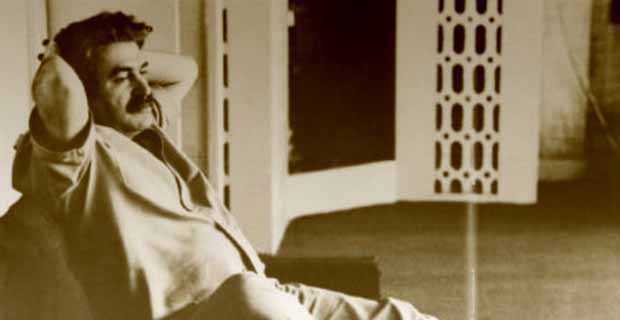
We Iranians who had among us Sa’edi, the physician-dramatist that taught us how to anatomize social maladies both on the stage and on the screen, know what grace it is when art and science come together in an artist. We already know what surgical operations the likes of Chekhov can perform in the realms of culture and social change.
Behzad Ghaderi
Physician writers in Persian literature are handful, and yet none has been as influential as Gholam-Hossein Saedi.
Saedi was born on January 4, 1936 Tabriz and passed away on November 23, 1985 in Paris. A short biography written by him reads:
Gholam Hossein Sa’edi was born to a middle-class family in 1314 solar [1935] in Tabriz. His father was a simple government employee. He attended elemnetray and high school in Tabriz. During his high school, which coincided with the pre-1935 coup, he had plenty of time and opportunity for reading and writing. He was responsible for three Persian newspapers in Tabriz while he was still a high school student. After the coup, he was arrested and imprisoned for a short time. He then entered medical school [at Tabriz University]. It was during this period that he started writing short stories for monthly periodicals. In his last years of medical school, he published a collection of short stories, Shab-neshini-e Bashokoh (An Elegant Party, pub. 1960), and two plays, Bamha va zire Bamha (Roofs and Beneath Roofs), and Kalateh Gol (the Name of an Iranian Village).
The first play was about the constitutional revolution, and the second one about the confiscation of lands by Reza Shah. This play was confiscated from bookstores by the police.
After finishing medical school, he was drafted into the army. Although he was named the top student in the field of primitive medicine at the military college, because of his past political activities he was given the rank of “Sarbaz-sefr” [ordinary private rather than an officer, which is ordinary conferred on all graduates]. After his military service [1962], he spent some time in the villages. Then he started his specialty in psychiatry [at Tehran University]. After obtaining his degree, he started working at a mental hospital while writing and publishing stories and plays until he was fired by SAVAK in 1968. His plays were regularly staged at Tehran’s Sanglaj Theatre.
He also had a private office next to Tehran’s old cemetery, Mesgarabad, for fifteen years, but took advantage of any opportunity to travel and observe all Iran. The fruits of his travelling in addition to stories and novels, were some monographs he wrote about villages and towns and one monograph concerning native [psychological] diseases of the south entitled Ahl-e Hava (The People of the Wind, 1966).
He has repeatedly been arrested and imprisoned by the police and SAVAK for “political activities.” In 1974, he went to Semnan (218 km east Tehran) to write another monograph about rural areas, and was hunted there by SAVAK. He spent one year in solitary confinement, and endured severe physical torture, the scars of which still remain. After his release, he devoted all his time to writing. Presently, he is preparing some monographs for publication. For the moment, he has left his medical practice. He is interested in anthropology, is single and lives alone.
GHOLAM HOSSEIN SA’EDI (GOWHAR MORAD) AS WRITER AND DRAMATIST
BOZORGMEHR, FARIDOZAMAN. The American University, ProQuest, UMI Dissertations Publishing, 1982. 1320133
BIBILO BRIEF
Short Story Collections
- Houses of Shahr-e Rey (Khaneh-haye Shahr-e Rey)
- A Magnificent Party (Shab Neshini-e Bashokouh)(1960)
- Mourners of Bayal (Azadaran-e Bayal)(1964)
- Dandil (1966)
- The Grave and the Cradle (Gour va Gahvareh)(1977)
- Nameless and Elusive Apprehensions (Vahemeh-haye Bi Namo Neshan)(1967)
- Fear and Trembling (Tarso Larz) (1968)
Novels
- The Cannon (Tup) (1969)
- Stranger in Town (Gharibeh Dar Shahr) (1990)
- The Grinning Tartar (Tatar-e Khandan) (1994)
Drama
- The End to Endless Writing (Aghebat Ghalam Farsai)(1975)
- Long A, short A (Aye Ba Kolah, Aye Bi Kolah) (1967)
- Tehran, directed by Jaʿfar Vāli, 1967; tr. Giselle Kapuscinski as “O Fool, O Fooled,” in idem, Modern Persian Drama, New York, 1987.
- The World’s Best Dad (Behtarin Babaye Donya) (1965)
- An eye for an eye (Cheshm dar barbare Cheshm) (1971)
- Club wielders of Varazil (Choub Be Dast-haye Varazil) (1965)
- Dictation and Angle (Dikteh Va Zavieh) (1969)
- The Successor (Janeshin) (1970)
- The Flower Hamlet (Kalat-e Gol) (1961)
- Housewarming(Khaneh Roshani) (1967)
- (Kārbāfakhā dar sangar), 1960; tr. David Chambers et al. as “Workaholics in Trenches”, in M. R. Ghanoonparvar, ed., Iranian Drama, Costa Mesa, 1989, pp. 1-63.
- Māh-e ʿasal, Tehran, 1978, tr. James Clark et al. as “Honeymoon,” in M. R. Ghanoonparvar, ed., Iranian Drama: an Anthology, Costa Mesa, 1989, pp.63-132.
- Mar dar maʿbad (A snake in the temple), Tehran, 1993.
- Otello dar sarzamin-e ʿajāyeb (Paris, 1986), tr. as Othello in Wonderland, by Michael Phillips and M.R. Ghanoonparvar, Calif. 1996.
- Panj nemāyešnāma az enqelāb-e mašruṭiyat (Five plays on the Constitutional Revolution), Tehran, 1966.
- Pardadārān-e āʾina afruz, Paris, 1986; tr. Michael Phillips and M.R. Ghanoonparvar as Mirror-polishing storytellers, Calif. 1996.
- Parvārbandān (The fattened lot, Figure 7), Tehran, 1969.
- Pigmalion, a free translation of George Bernard Shaw’s play, Tabriz, 1956.
- Vāy bar maḡlub (Woe to the vanquished), Tehran, 1970; staged by Dāvud Rašidi, 1970.


Leave a Reply